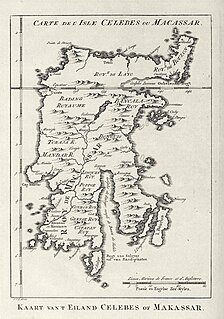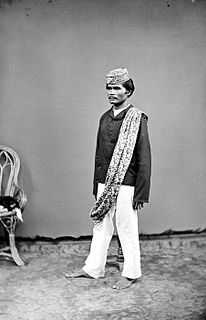This page is based on this
Wikipedia article Text is available under the
CC BY-SA 4.0 license; additional terms may apply.
Images, videos and audio are available under their respective licenses.

Melanesia is a subregion of Oceania extending from New Guinea island in the southwestern Pacific Ocean to the Arafura Sea, and eastward to Fiji.

South Sulawesi is a province in the southern peninsula of Sulawesi. The Selayar Islands archipelago to the south of Sulawesi is also part of the province. The capital is Makassar. The province is bordered by Central Sulawesi and West Sulawesi to the north, the Gulf of Bone and Southeast Sulawesi to the east, Makassar Strait to the west, and Flores Sea to the south.
The Buginese people are an ethnic group—the most numerous of the three major linguistic and ethnic groups of South Sulawesi, in the southwestern province of Sulawesi, third largest island of Indonesia. The Austronesian ancestors of the Buginese people settled on Sulawesi around 2500 B.C.E. There is "historical linguistic evidence of some late Holocene immigration of Austronesian speakers to South Sulawesi from Taiwan"—which means that the Buginese have "possible ultimate ancestry in South China", and that as a result of this immigration, "there was an infusion of an exogenous population from China or Taiwan." Migration from South China by some of the paternal ancestors of the Buginese is also supported by studies of Human Y-chromosome DNA haplogroups. The Bugis in 1605 converted to Islam from Animism. Some Buginese have retained their pre-Islamic belief called Tolotang, and some Bugis converted to Christianity by means of marriage; but they have remained a minority.

Bugis, in Singapore, was renowned internationally from the 1950s to the 1980s for its nightly gathering of transvestites and transsexuals, a phenomenon which made it one of Singapore's top tourist destinations during that period.

More than 700 living languages are spoken in Indonesia. A major part of them belong to the Austronesian language family, while over 270 Papuan (non-Austronesian) languages are spoken in eastern Indonesia.. The official language is Indonesian, a standardized form of Malay, which serves as the lingua franca of the archipelago. The vocabulary of Indonesian borrows heavily from regional languages of Indonesia, such as Javanese, Sundanese and Minangkabau, as well as from Dutch, Sanskrit and Arabic.

The Lontara script is a Brahmic script traditionally used for the Bugis, Makassarese and Mandar languages of Sulawesi in Indonesia. It is also known as the Bugis script, as Lontara documents written in this language are the most numerous.

The Kingdom of Luwu is the oldest kingdom in South Sulawesi. In 1889, the Dutch Governor of Makassar placed Luwu's heyday between the 10th and 14th centuries, but offered no evidence. The La Galigo, an epic poem in an archaic form of the lontara language, is the likely source of Braam Morris’ dating. The La Galigo depicts a vaguely defined world of coastal and riverine kingdoms whose economies are based on trade. The important centers of this world are Luwu and the kingdom of Cina, which lay in the western Cenrana valley, with its palace centre near the hamlet of Sarapao in Pamanna district. The incompatibility of the La Galigo's society and political economy with the reality of the Bugis agricultural kingdoms led Bugis historians to propose an intervening period of chaos to separate the two chronologically.
Mandar is an Austronesian language spoken by the Mandar ethnic group living in West Sulawesi province of Indonesia, especially in the coastal regencies of Majene and Polewali Mandar, as well as in a few settlements in the islands of Pangkep District and Ujung Lero, a small peninsula near Pare-Pare).

The languages of Papua New Guinea today number over 850. These languages are spoken by the inhabited tribal groups of Papua New Guinea and Indonesia. In 2006, Prime Minister Sir Michael Somare stated that "Papua New Guinea has 832 living languages " making it the most linguistically diverse place on earth. Its official languages are Tok Pisin, English, Hiri Motu and Papua New Guinean Sign Language. Tok Pisin, an English-based creole, is the most widely spoken, serving as the country's lingua franca. Papua New Guinean Sign Language became the fourth official language in May 2015, and is used by the deaf population throughout the country.

New Guinea is a large island separated by a shallow sea from the rest of the Australian continent. It is the world's second-largest, after Greenland, covering a land area of 785,753 km2 (303,381 sq mi), and the largest wholly or partly within the Southern Hemisphere and Oceania.
The Buginese People, or the Bugis, are an ethnic group of Austronesian ancestry that inhabit parts of Southeast Asia
The Bima language, or Bimanese is an Austronesian language spoken on the eastern half of Sumbawa Island, Indonesia, which it shares with speakers of the Sumbawa language. Bima territory includes the Sanggar Peninsula, where the extinct Papuan language Tambora was once spoken. "Bima" is an exonym; the autochthonous name for the territory is "Mbojo" and the language is referred to as "Nggahi Mbojo." There are over half a million Bima speakers. Neither the Bima nor the Sumbawa people have alphabets of their own for they use the alphabets of the Bugis and the Malay language indifferently.

The Makassar people are an ethnic group that inhabits the southern part of the South Peninsula, Sulawesi in Indonesia. They live around Makassar, the capital city of the province of South Sulawesi, as well as the Konjo highlands, the coastal areas, and the Selayar and Spermonde islands. They speak Makassarese, which is closely related to Buginese and also a Malay creole called Makassar Malay.









